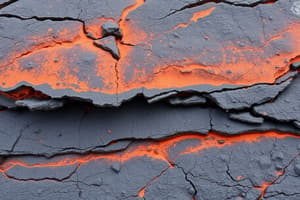Podcast
Questions and Answers
What type of lava is characterized by its low viscosity and ability to flow easily into ropey strands?
What type of lava is characterized by its low viscosity and ability to flow easily into ropey strands?
- Basaltic
- Felsic
- Pahoehoe (correct)
- Aa
Which type of volcanic rock typically has higher silica content and forms aa-style flows?
Which type of volcanic rock typically has higher silica content and forms aa-style flows?
- Felsic (correct)
- Mafic
- Intermediate
- Basaltic
What geological feature is primarily formed from lava that hardens on the outside while continuing to flow internally?
What geological feature is primarily formed from lava that hardens on the outside while continuing to flow internally?
- Lava tube (correct)
- Volcanic fissure
- Lava dome
- Shield volcano
What is the main characteristic of mafic lava that typically emerges from fissures?
What is the main characteristic of mafic lava that typically emerges from fissures?
What is the primary geological feature of Olympus Mons on Mars?
What is the primary geological feature of Olympus Mons on Mars?
What shape and type of volcano is primarily characterized by multiple layers built from lava flows and tephra?
What shape and type of volcano is primarily characterized by multiple layers built from lava flows and tephra?
Which term is used to describe the small volcano located on the flank of a larger volcano?
Which term is used to describe the small volcano located on the flank of a larger volcano?
What is the primary factor that influences the shape and eruption style of a volcano?
What is the primary factor that influences the shape and eruption style of a volcano?
Which of the following best describes calderas?
Which of the following best describes calderas?
What characteristic distinguishes basaltic volcanism typically seen in Hawaiian shield volcanoes?
What characteristic distinguishes basaltic volcanism typically seen in Hawaiian shield volcanoes?
What primarily composes a cinder cone?
What primarily composes a cinder cone?
Which event is characteristic of cinder cone eruptions?
Which event is characteristic of cinder cone eruptions?
What is a notable feature of the cinder cone at Paricutin, Mexico?
What is a notable feature of the cinder cone at Paricutin, Mexico?
Which describes the structure of cinder cones?
Which describes the structure of cinder cones?
Where are cinder cones predominantly located?
Where are cinder cones predominantly located?
Flashcards
Stratovolcano features
Stratovolcano features
A composite volcano characterized by alternating layers of lava and tephra (ash).
Viscosity
Viscosity
A fluid's resistance to flowing.
Parasitic cone
Parasitic cone
A small volcano formed on the flank of a larger volcano, having its own vents.
Caldera
Caldera
Signup and view all the flashcards
Lava Flow
Lava Flow
Signup and view all the flashcards
Basaltic Lava Types
Basaltic Lava Types
Signup and view all the flashcards
Lava Tubes
Lava Tubes
Signup and view all the flashcards
Fissure Eruptions
Fissure Eruptions
Signup and view all the flashcards
Pahoehoe Lava
Pahoehoe Lava
Signup and view all the flashcards
Olympus Mons
Olympus Mons
Signup and view all the flashcards
Cinder Cone
Cinder Cone
Signup and view all the flashcards
Pyroclastic fragments
Pyroclastic fragments
Signup and view all the flashcards
Cinders
Cinders
Signup and view all the flashcards
Short-lived eruption
Short-lived eruption
Signup and view all the flashcards
Mafic lava
Mafic lava
Signup and view all the flashcards
Study Notes
Igneous Processes and Volcanoes
- Bowen's Reaction Series relates minerals to temperature
- Igneous minerals crystallize at different temperatures
- Mafic igneous rocks contain more mafic minerals and crystallize at higher temperatures than felsic igneous rocks
- Bowen's work founded igneous petrology
- Magma contains melt, solids, and volatiles.
- Melt is ions from liquefied minerals
- Solids are crystallized minerals in the liquid melt
- Volatiles are dissolved gases like water vapor, carbon dioxide, sulfur, and chlorine
- The presence and amount of these components affect magma's physical behavior
- Geothermal gradients relate temperature increase to depth
- Earth's average geothermal gradient is about 25°C per kilometer in the top 100 km of the crust
- Melting temperature increases with pressure at greater depth
- Water boils at a lower temperature with lower pressure
Volcanism
- Magma that reaches the Earth's surface is called lava
- Volcanoes are land formations where lava solidifies
- Most volcanoes are interplate volcanoes located at active plate boundaries, like mid-ocean ridges, and subduction zones.
- Continental rifts can also cause volcanism.
- Some volcanoes are intraplate volcanoes located within tectonic plates.
- Hotspots can create intraplate volcanoes
- Volcanism is related to plate tectonics
- Hazards of volcanism can include lava flows, pyroclastic flows, lahars, and landslides
- Monitoring volcanoes helps predict eruptions and mitigate hazards.
Studying That Suits You
Use AI to generate personalized quizzes and flashcards to suit your learning preferences.




